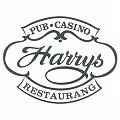On 18 February 2016, the General Court issued its decision in the HARRY’S BAR case (T-711/13 and T-716-13), where, adopting a rather broad brush approach, it held that food and beverage products were similar – at least to a certain degree – to services of provision of food and drink in class 43. Harry’s New York Bar SA was therefore denied registration of HARRY’S BAR as a CTM on account of earlier Swedish trademarks for the following mark:
OHIM’s First Board of Appeal had taken a far more differentiated position, finding similarity only in relation to such products which are typically or frequently offered in establishments of the same name. This was denied for foodstuffs apart from prepared meals, and for non-alcoholic beverages that do not normally carry the brand of the restaurant or bar where they are served.
The General Court, however, knew it better. On the (simplistic) basis that meat, eggs, rice, sugar etc. as well as any kind of beverages are “necessarily used in the serving of food and drink” and therefore “complementary”, and that they are “used and offered through restaurant, pub and café services” for that reason “closely connected with those services”, it held that there was a “certain degree of similarity” between those goods and services.
This must be seen against the background of in-depth discussions in OHIM’s Knowledge Circles in 2015 precisely concerning this topic and OHIM’s latest revision of the Guidelines supporting a much more careful approach. Indeed, if the General Court has got it right here, one might as well advise anyone in the food or beverage industry to simply register class 43 to “cover it all”. Similarly, applying the same sweeping approach, restaurant services should also be similar to class 8 (cutlery), 16 (menus), 20 (furniture), 21 (glassware) etc., as all these goods are clearly indispensable for running a restaurant.
The General Court did not ask the important question whether the consumers would actually think that the goods and services might come from the same or connected sources, provided they bear the same brand. This happens only where there is a custom in trade for the same company to offer both, the services and the goods, under the same brand. It is suggested that, had this question been asked, the outcome would have been different. Of course, neither the source nor the trade channels are factors contemplated by the 1998 Canon judgment (C‑39/97). The criteria mentioned there were the nature, intended purpose and method of use of the goods at issue, and whether they are in competition with each other or are complementary. However, common source or trade channels are indeed the most market-oriented and therefore important criteria.
It is hoped that either Harry’s New York Bar SA or OHIM (or both) take this question to the Court of Justice. As the General Court’s decision is contrary to both previous case law and OHIM’s Guidelines, OHIM may well be prompted to appeal. And if this happens, fingers crossed that the Court of Justice takes the opportunity to impose more differentiation and a more careful appreciation of the various factors involved when assessing the similarity of goods, recognising the importance of a likely assumption of a common source. The Canon criteria are in dire need of modernisation and amendment.
_____________________________
To make sure you do not miss out on regular updates from the Kluwer Trademark Blog, please subscribe here.



